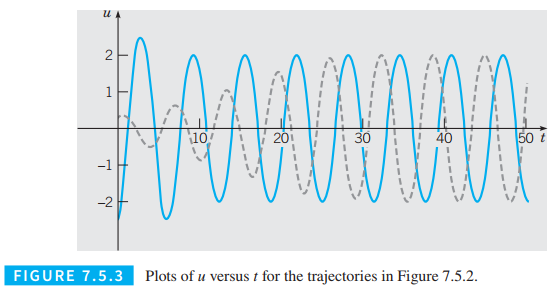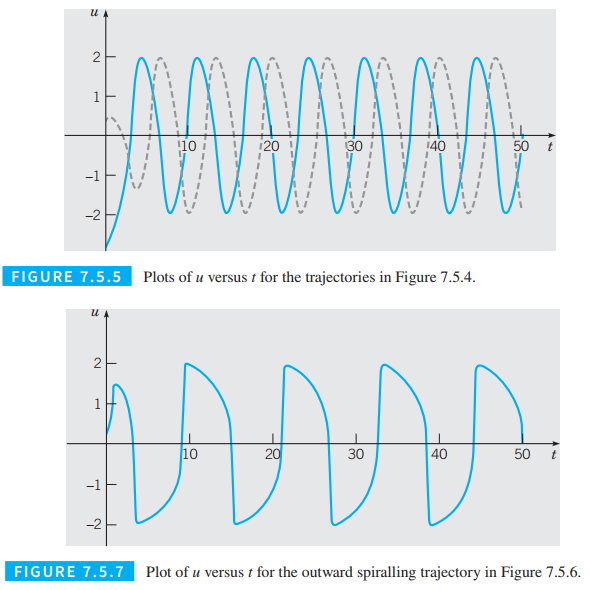
Concept explainers
a) By examining the graphs of
b) Calculate and plot the graphs of solutions of the van der Pol equation for other values of the parameter
c) Plot the estimated values of


Want to see the full answer?
Check out a sample textbook solution
Chapter 7 Solutions
DIFFERENTIAL EQUATIONS-NEXTGEN WILEYPLUS
Additional Math Textbook Solutions
A First Course in Probability (10th Edition)
Calculus: Early Transcendentals (2nd Edition)
Precalculus: Mathematics for Calculus (Standalone Book)
Thinking Mathematically (6th Edition)
Introductory Statistics
Elementary Statistics (13th Edition)
- Question 3: A sealed flask at room temperature contains a mixture of neon (Ne) and nitrogen (N2) gases. Ne has a mass of 3.25 g and exerts a pressure of 48.2 torr. . N2 contributes a pressure of 142 torr. • What is the mass of the N2 in the flask? • Atomic mass of Ne = 20.1797 g/mol • Atomic mass of N = 14.0067 g/mol Solution: We will use the Ideal Gas Law to determine the number of moles of each gas and calculate the mass of N2. PV = nRT where: • P = total pressure • V volume of the flask (same for both gases) n = number of moles of gas • R 0.0821 L atm/mol K • T = Room temperature (assume 298 K) Since both gases are in the same flask, their partial pressures correspond to their mole fractions. Step 1: Convert Pressures to Atmospheres 48.2 PNe = 0.0634 atm 760 142 PN2 = = 0.1868 atm 760 Step 2: Determine Moles of Ne nNe = mass molar mass 3.25 nNe 20.1797 nne 0.1611 mol Step 3: Use Partial Pressure Ratio to Find narrow_forward"I have written solutions in text form, but I need experts to rewrite them in handwriting from A to Z, exactly as I have written, without any changes."arrow_forwardNo chatgpt pls will upvote Already got wrong chatgpt answerarrow_forward
- Construct a table of values for all the nonprincipal Dirichlet characters mod 16.arrow_forwardMI P X /courses/segura10706/products/171960/pages/611?locale=&platformId=1030&lms=Y ☆ Finish Part I: Mathematics for Elementary and Middle School Teachers Continue in the app JJ 576 Chapter 12. Area of Shapes 9. Determine the area of the shaded shapes in Figure 12.48. Explain your reasoning. 1 unit S Figure 12.48 1 unit unit and the yarn for thearrow_forwardSuppose p > 3 is a prime. Show that (p − 3)!= − P+1 (mod p). Hint: Use Wilson's theorem.arrow_forward
- Which graph represents f(x) = √x-2+3?arrow_forwardSuppose a = p²¹...p be the canonical factorization. Then the sum of all the factors of a, denoted by σ(a) is given by o(a) = II + k₂+1 P -1 Pi - 1 (you don't need to prove this). (a) Let a = 2³ × 7². Find σ(a), which the sum of all the factors a.arrow_forwardEvaluate the Legendre symbol (999|823). (Note that 823 is prime.)arrow_forward
- If p = 7 (mod 8), where p is prime, show that p divides 2(p-1)/2 — 1. Deduce that 275 - 1 and 2155 -1 are composite.arrow_forwardSolve the simultaneous linear congruences 3x = 2 (mod 5), 3x = 4 (mod 7), 3x = 6 (mod 11).arrow_forwardcondition: Throughout this question, n is a positive integer satisfying the following (n) = 2³ × 17 × q, gcd(n,6) = 1, q = 2(mod3) is an odd prime. (a) Show that 17†n. - (b) Show that 17|(p − 1) for some prime factor p of n.arrow_forward
 Trigonometry (MindTap Course List)TrigonometryISBN:9781337278461Author:Ron LarsonPublisher:Cengage Learning
Trigonometry (MindTap Course List)TrigonometryISBN:9781337278461Author:Ron LarsonPublisher:Cengage Learning Mathematics For Machine TechnologyAdvanced MathISBN:9781337798310Author:Peterson, John.Publisher:Cengage Learning,Algebra & Trigonometry with Analytic GeometryAlgebraISBN:9781133382119Author:SwokowskiPublisher:Cengage
Mathematics For Machine TechnologyAdvanced MathISBN:9781337798310Author:Peterson, John.Publisher:Cengage Learning,Algebra & Trigonometry with Analytic GeometryAlgebraISBN:9781133382119Author:SwokowskiPublisher:Cengage


